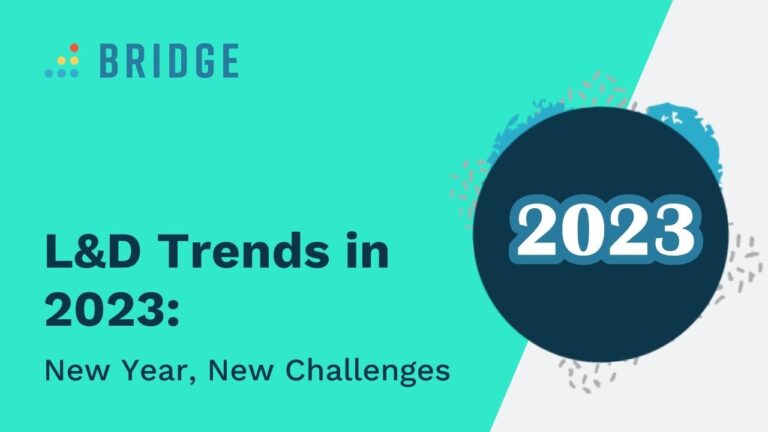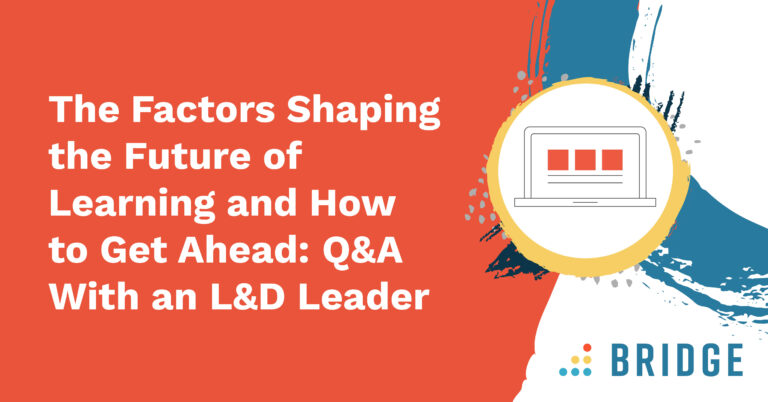For L&D teams, the start of a new year is a great time to reflect on how your LMS can help your organization to face the challenges and opportunities of the next 12 months. At the same time, it can be hard to know where to look in the face of economic turbulence, evolving technologies, and the ever-changing state of learner expectations.
Luckily, we’ve done the hard work for you by collecting a selection of the most pressing L&D trends to watch out for in 2023. From artificial intelligence to learning in the age of TikTok, discover how to shape your learning content and wield your performance tools in order to keep your employees happy, upskilled, and ready to face the new year with confidence.
Learner Expectations in 2023: An Algorithmic Helping Hand
We all expect content that’s tailored to our interests, whether that’s a movie recommendation or a suggested product to buy. Why should learning be any different?
Learners will expect the occasional algorithmic intervention to nudge them in the right direction in 2023.
In fact, many learners will recognize that searching for the right training content can only get them so far. After all, they don’t know what they don’t know!
That’s why LMSs and talent platforms will increasingly look to deliver content based on learner behaviors. They’ll use data like recommendations to anticipate and serve training programs that learners didn’t even know they needed.
Multimedia Methods for Microlearning
As L&D methods catch up with learner expectations, employees won’t just expect to be served learning content in familiar ways—they’ll also expect the format of their content to align with their preferences.
It’s been well established that, in an age of social media and amid the rise of short-form videos on platforms like TikTok, plenty of people get their information through bite-sized content. In fact, one Google executive has claimed that around 40% of young people use TikTok or Instagram to find the facts they need through short-form videos.
For L&D teams, this means placing an emphasis on multimedia microlearning.
The lengthy courses of yesterday need to be supplemented by short, impactful, and sometimes video-led learning experiences—and the sooner your L&D team embraces these changes, the better your learning outcomes will be!
Career-Led Incentives for Learning Pathways
In the year ahead, learning journeys and pathways will continue growing in popularity as more organizations recognize the utility of automated, spaced-out learning delivery.
The immediate benefits of breaking up learning into manageable chunks and delivering courses at appropriate intervals are obvious—but the advantages don’t end there.
If there’s a lesson to be learned from 2022’s ‘Great Resignation’, it’s that employees who don’t feel they’re progressing are increasingly prepared to fulfil their ambitions elsewhere. By embracing learning pathways, however, you’ll motivate your people to learn by providing them with a sense of forward momentum and purpose.
Learning journeys transform the learning experience, ensuring that your courses aren’t seen as chores, but as stepping stones toward promotions, new fields, and other career aspirations.
Not only will this approach help with retention in the coming year, but it’ll also provide a powerful incentive for your people to enthusiastically participate in your learning schemes. It’s not just a learning path—it’s a career path, too.
New Metrics for Measuring L&D Success: Impact Over Usage
Thinking about the usefulness of your learning isn’t just a great motivator for your learners—it’s also the key to measuring how effective your learning program is.
When you’re looking to assess the impact of your L&D strategies, it can be tempting to focus on usage-related metrics like how much time your learners spend in your LMS, how many courses they’re completing, and so on.
However, this kind of approach comes with a pretty hefty caveat. It’s great when a given learner logs on every day of the week, but this statistic doesn’t mean much if they’re not using their newfound knowledge to enhance their job performance or improve their prospects.
By placing an emphasis on learning outcomes, however, you’ll quickly find more meaningful ways to measure the success of your programs. If, for example, one of your learners has used one of their new skills to get a new client or enhance a product, you can be confident that your L&D team played a part in these measurable wins.
Sophisticated performance analytics that put impact first will, therefore, be a huge factor in analyzing your learning programs in 2023.
TAKE A CLOSER LOOK AT METRICS | ‘What Are SMARTER Goals and How Do They Help Measure Employee Productivity?’
Wellbeing at Work
We’re all aware of the new raft of wellbeing challenges brought on over the past couple of years, as the unfamiliar world of displaced working came hand-in-hand with new or exacerbated issues like:
- Video meeting fatigue
- Lone wolf syndrome
- Home-based distractions including kids and pets
In 2023, we’re likely to see a more solid commitment to hybrid working, requiring many employees to negotiate the tricky mental health implications for both remote and in-person working.
With 52% of employees feeling unsupported by their employers, your approach to learning, development, and performance will have a part to play in keeping your people mentally safe wherever they’re working.
Whatever the specifics of your strategy might be, it’s a good idea to start by embracing the idea of psychological safety, ensuring that your team members can speak their minds without worrying about being embarrassed or punished by their colleagues.
This kind of friendly and encouraging environment can be fostered in your 1:1 meetings. With the right performance tools, you’ll be able to keep your meetings frequent and ensure your people have a say when it comes to the agenda. This approach ensures you’re offering those all-important human connections that remote and hybrid work can often do away with.
DISCOVER THE BEST WAYS TO KEEP YOUR PEOPLE HAPPY | ‘How to Boost Employee Wellbeing in the Workplace’
Performance Management Trends: Putting the Human at the Heart of Your Mission
Human connection isn’t just necessary for your 1:1 meetings. In terms of performance and employee development, there’s an ongoing shift toward the human as a key driver for change, behavior, skills, and beyond.
What does that mean for the year ahead? For one thing, it means L&D and performance management strategies need to engage and motivate the individual—whether we’re talking about their career journey, personal goals, wellbeing, or skills that aren’t directly related to their core job.
This trend is something that will need to be taken to heart in the world of performance management, which tends to gravitate toward structural, defined, and cyclical activities. Blending these with ad hoc, human-centric engagement will be an essential way to meet the human needs that power your organization throughout 2023 and beyond.
At the same time, however, this pivot toward the human aspects of performance shouldn’t come at the cost of cold, hard data! In the unpredictable economic waters of 2023, business leaders will still need facts and figures to inform performance decisions, especially in the context of compensation.
Artificial Intelligence: A Learning Topic or General-Purpose L&D Tool?
Even as AI reaches the peak of the hype cycle, the pace of technological development is pretty staggering. In the last year alone, we’ve seen remarkable advances in areas like text-to-image generation via tools including the popular DALL-E. Similarly, large language models like GPT-3 and PaLM are producing dramatic results that would have been unthinkable a decade ago.
These advances are ushering in a new generation of applications in disciplines as diverse as copywriting, video production, and coding. But what does all this mean for L&D in the year ahead?
There are two ways to look at AI’s relationship to L&D. Firstly, learning teams will be called upon to help employees learn the new skills necessary to use this technology. Secondly, and more excitingly, AI technologies could streamline the production of lower-value text, video, and image assets, letting learning and other creative teams focus on creating more compelling and memorable learning experiences.
It’s also worth acknowledging that the nature of the technology opens up ethical and legal questions which will need to be tackled by well-prepared and well-informed leaders.
The State of Internal Mobility in 2023
Part of looking at the year ahead involves taking a glance at the twists and turns of the past 12 months—and that’s especially applicable in the world of business attrition and employee retention.
2022 saw an intense war for talent, with Ernst & Young reporting that 43% of employees were prepared to quit within a year, confident they would land on their feet in a favorable employment landscape.
Obviously, demand for labor is always going to wax and wane in line with broader economic forces, but the lesson remains the same: if you want to retain employees and find the right skills in 2023, it’s best to start internally. When employees find it easier to land internal opportunities than external ones, turnover drops—and when you need to fill a vital skills gap, internal mobility will give you the means to grow the right talent from within.
Whatever the economic circumstances of the year ahead, internal mobility is always going to play a key role in keeping your skill gaps filled and your people fulfilled.
Mind the (Engagement) Gap
Across 2021 and 2022, employee engagement in the US saw a historic (but unfortunate!) milestone: engagement levels decreased in what Gallup highlights as the first annual decline in a decade.
The decline is especially notable for employees who work exclusively on-site: only 29% of these individuals were considered engaged in 2022. Gallup also found that employees who are required to work on-site but prefer hybrid or fully remote schemes have significantly lower engagement, worse wellbeing, and higher intent to leave.
These revelations will undoubtedly see organizations move in the direction of hybrid work—but the path toward an engaged workforce doesn’t end there.
For L&D professionals, these declines can only mean one thing: more pressure than ever before to leverage the power of L&D to increase employee engagement. Whether it’s through career mobility, the fulfillment of personal goals, or performance tools that keep your people connected, engagement will be a vital piece of the L&D puzzle in 2023.
As such, it’ll be worth pairing your extra-engaging L&D approach with an employee engagement survey tool. The right tool will allow you to gain a comprehensive insight into how engaged your people are (and where your learning program might benefit from the occasional tweak!)
KEEP YOUR PEOPLE ENGAGED | ‘3 Employee Engagement Ideas for Remote Workers’
Navigating the Three Pillars for Corporate Skills Strategy: Hire, Upskill, Reskill
According to a Gallup study on upskilling, more than 52% of American workers say they’ve participated in an upskilling program in the past year. At the same time, McKinsey has found that the top reason for leaving jobs in 2022 is a lack of career development and advancement opportunities.
These insights shine a light on the talent-related priorities of 2023. When faced with the choice of acquiring skills, upskilling, and reskilling, plenty of organizations will focus on the latter two options. Not only will this help with employee retention, as Gallup and McKinsey both imply, but this emphasis on training and development will also help organizations fill those skills gaps without compromising any workforce reductions or delayed hiring policies.
Master 2023’s L&D Trends With Bridge
Whether you’re looking to forge new learning pathways or place a renewed focus on employee wellbeing, Bridge has the tools you need to face the L&D challenges of the new year with confidence. Get a taste of what our LMS can do with a free demo.




